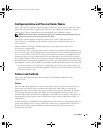
Using MSCS 67
Configuring Active and Passive Cluster Nodes
Active nodes process application requests and provide client services. Passive nodes are backup
nodes that ensure that client applications and services are available if a hardware or software
failure occurs. Cluster configurations may include both active and passive nodes.
NOTE: Passive nodes must be configured with appropriate processing power and storage capacity to
support the resources that are running on the active nodes.
Your cluster solution supports variations of active/active (active
x
) and active/passive
(active
x
/passive
x
) configurations. The variable x indicates the number of nodes that are
active or passive.
Cluster solutions running the Windows operating system support active/active and
active/passive configurations.
An active/active (active
x
) configuration contains virtual servers running separate applications or
services on each node. When an application is running on node 1, the remaining node(s) do not
have to wait for node 1 to fail. Those node(s) can run their own cluster-aware applications (or
another instance of the same application) while providing failover for the resources on node 1.
For example, multiway failover is an active/active failover solution because running applications
from a failed node can migrate to multiple active nodes in the cluster. However, you must ensure
that adequate resources are available on each node to handle the increased load if one node fails.
•
In an active/passive (active
x
/passive
x
) configuration, one or more active cluster nodes are
processing requests for a clustered application while the passive cluster nodes only wait for
the active node(s) to fail.
Failover and Failback
This section provides information about the failover and failback capabilities of the
Cluster Service.
Failover
When an individual application or user resource (also known as a cluster resource) fails on a
cluster node, the Cluster Service will detect the application failure and try to restart the
application on the cluster node. If the restart attempt reaches a preset threshold, the Cluster
Service brings the running application offline, moves the application and its resources to
another cluster node, and restarts the application on the other cluster node(s). This process of
automatically moving resources from a failed cluster node to other healthy cluster node(s) is
called failover.
In order to fail over and fail back running applications, cluster resources are placed together in a
group so the Cluster Service can move the cluster resources as a combined unit. This process
ensures that the failover and/or failback procedures transfer all of the user resources as
transparently as possible.
se500wbk1.book Page 67 Thursday, June 16, 2005 4:19 PM


















